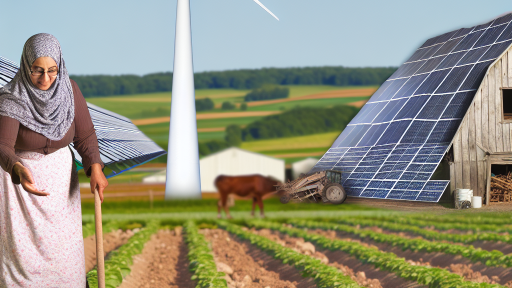Introduction to Government Conservation Incentives for Farmers
Government conservation incentives play a vital role in agriculture.
These incentives support farmers in adopting sustainable practices.
As a result, they contribute to environmental protection and resource management.
Purpose of Conservation Incentives
The main purpose is to encourage sustainable farming methods.
Farmers can benefit economically while preserving natural resources.
Consequently, these practices enhance soil health and water quality.
Types of Incentives Available
Various government programs offer conservation incentives for farmers.
Financial assistance is one form of support.
Moreover, technical assistance helps farmers implement new practices.
For example, cost-share programs reduce the financial burden of adopting conservation measures.
Additionally, tax incentives reward environmentally friendly practices.
Eligibility and Application Process
Eligibility for these programs typically depends on specific criteria.
Farm size, location, and current practices are key factors.
Farmers must often complete an application to access these incentives.
In many cases, local agricultural offices provide guidance and resources.
Transform Your Agribusiness
Unlock your farm's potential with expert advice tailored to your needs. Get actionable steps that drive real results.
Get StartedConsequently, farmers should stay informed about available programs.
Benefits of Participation
Participation in conservation programs offers numerous benefits.
Farmers can improve their land’s productivity over time.
Additionally, environmental quality sees significant enhancements.
Furthermore, these practices can strengthen community relationships.
Consequently, farmers contribute to a more sustainable food system.
Overview of Types of Conservation Programs Available
Federal Conservation Programs
The federal government offers various conservation programs to support farmers.
These programs aim to promote sustainable farming practices.
One key program is the Conservation Reserve Program (CRP).
The CRP pays farmers to convert environmentally sensitive land into native vegetation.
This initiative enhances wildlife habitats and improves water quality.
Another important program is the Environmental Quality Incentives Program (EQIP).
EQIP provides financial assistance for adopting conservation practices.
Farmers can receive funding for soil erosion control, irrigation improvements, and more.
State-Based Conservation Programs
Many states also offer their own conservation incentives.
State programs often complement federal initiatives.
For example, California has the State Water Efficiency and Enhancement Program (SWEEP).
This program helps farmers implement projects that save water and reduce costs.
In New York, the Agricultural Environmental Management (AEM) program supports sustainable farming.
AEM encourages farmers to develop tailored environmental plans.
These state programs are critical for addressing regional conservation needs.
Non-Governmental Initiatives
In addition to government programs, non-profits contribute to conservation efforts.
Organizations like the Nature Conservancy offer grants to farmers.
These grants support projects that improve ecosystems and agricultural practices.
Showcase Your Farming Business
Publish your professional farming services profile on our blog for a one-time fee of $200 and reach a dedicated audience of farmers and agribusiness owners.
Publish Your ProfileMoreover, local conservation districts provide technical assistance.
Farmers can receive guidance on implementing conservation measures.
Eligibility and Application Processes
Farmers should understand the eligibility criteria for these programs.
Different programs have varied application requirements.
For federal programs, farmers typically need to demonstrate land compliance.
This may involve providing detailed farm operation information.
It is essential to explore deadlines and submission guidelines.
Starting early can ensure a smoother application process.
Eligibility Criteria for Farmers to Access Conservation Incentives
Understanding the Basics
Farmers interested in conservation incentives must meet specific eligibility criteria.
These criteria often vary depending on the program and location.
In general, farmers must operate a farm that produces agricultural commodities.
Additionally, they should demonstrate a commitment to sustainable practices.
Type of Farming Operations
Eligible operations include crop production, livestock farming, and specialty crops.
Furthermore, organic and sustainable farming practices often qualify for various programs.
Farmers should verify that their operations comply with local guidelines.
Land Requirements
Farmers must own or lease the land they wish to use for conservation practices.
Moreover, the land should be actively managed and capable of supporting agriculture.
Any land in active conservation or enrolled in other programs may impact eligibility.
Income and Financial Criteria
Many programs require evidence of agricultural income to determine eligibility.
Farmers should keep accurate and up-to-date financial records for review.
Additionally, some programs have minimum income thresholds or limits on aid.
Commitment to Conservation Practices
Farmers must express a genuine commitment to adopting conservation measures.
They might need to develop a conservation plan approved by a local agency.
Participation in educational programs can also demonstrate this commitment.
Application Process
Farmers should apply for specific conservation programs based on their eligibility.
Applications typically require submission of supporting documents.
Additionally, farmers may need to attend informational sessions or workshops.
Staying informed about deadlines and requirements is crucial for success.
Review and Approval
Once submitted, applications undergo a review process by local or state agencies.
Farmers will receive notifications regarding the status of their applications.
Commitment to follow-up actions may be necessary if the application is approved.
Understanding and meeting all criteria ensures access to valuable incentives.
See Related Content: Climate-Smart Agriculture Conservation Initiatives
Impact of Conservation Practices on Farm Economics
Understanding Conservation Practices
Conservation practices play a vital role in sustainable farming.
Farmers implement these methods to enhance soil health.
Moreover, they reduce erosion and improve water quality.
These efforts lead to more productive and resilient agricultural systems.
Economic Benefits for Farmers
Farmers experience various economic benefits from conservation practices.
Initially, these practices may require investment.
However, they often result in long-term savings.
Showcase Your Farming Business
Publish your professional farming services profile on our blog for a one-time fee of $200 and reach a dedicated audience of farmers and agribusiness owners.
Publish Your ProfileFor instance, improved soil health can reduce fertilizer costs.
Increased efficiency leads to lower input costs over time.
Accessing Government Incentives
The government offers incentives to encourage conservation.
Programs like the Conservation Reserve Program provide financial assistance.
Farmers can receive payments for implementing conservation measures.
These programs may cover practices like reforestation and wetland restoration.
Improving Market Opportunities
Adopting conservation practices can enhance market opportunities.
Many consumers prefer products from environmentally-friendly farms.
By promoting sustainability, farmers can tap into this market demand.
Additionally, they improve their overall brand image.
Challenges and Considerations
While conservation practices offer many benefits, challenges exist.
Farmers must understand the upfront costs involved.
They may also face barriers in accessing government programs.
However, staying informed can help overcome these obstacles.
Long-Term Economic Sustainability
Ultimately, conservation practices contribute to long-term farm sustainability.
By protecting natural resources, farmers ensure future productivity.
This leads to better resilience against climate change impacts.
In essence, integrating conservation into farming economics is beneficial.
Find Out More: How Farmers Can Access Government Grants for Agricultural R&D Projects
Step-by-Step Guide to Applying for Conservation Incentives
Understand the Available Programs
Begin by researching the various conservation incentive programs available.
Consider programs offered by local, state, and federal agencies.
Examples include the Conservation Reserve Program and the Environmental Quality Incentives Program.
Identify which programs align with your farming practices and goals.
Gather Required Documentation
Collect all necessary documentation needed for your application.
This may include farm management plans and financial records.
Ensure you have proof of land ownership or leasing agreements.
Additionally, gather any records of previous conservation efforts.
Consult with Local Experts
Reach out to local agronomists or extension agents for guidance.
They can provide insights tailored to your region and farming practices.
Consider attending workshops that focus on conservation programs.
Networking with other farmers can also yield beneficial advice.
Complete the Application Process
Carefully fill out the application forms for your chosen program.
Double-check for any required signatures or additional documentation.
Submit your application before the designated deadline.
Make copies of all submitted materials for your records.
Follow Up on Your Application
After submission, monitor the status of your application.
Contact the agency to confirm receipt and inquire about processing times.
Be prepared to provide any additional information if requested.
Patience is key, as processing times may vary significantly.
Implement Conservation Practices
If approved, begin implementing the designated conservation practices.
Showcase Your Farming Business
Publish your professional farming services profile on our blog for a one-time fee of $200 and reach a dedicated audience of farmers and agribusiness owners.
Publish Your ProfileAdhere closely to the guidelines set forth in your agreement.
Consider scheduling regular assessments to evaluate progress.
Document changes and improvements made on your farm.
Maintain Compliance and Reporting
Stay compliant with all program requirements throughout the duration.
This may include reporting on progress and outcomes.
Understand that failure to comply can result in penalties or loss of funding.
Set reminders for reporting deadlines to stay organized.
Discover More: Maximizing Agricultural Research and Development Funding: Tips for Farmers

Case Studies Highlighting Successful Conservation Projects
Restoration of Wetlands in Mississippi
The Mississippi Wetlands Restoration Project transformed degraded land into thriving wetlands.
Local farmers engaged with conservation organizations to restore natural habitats.
This collaboration led to improved water quality and enhanced biodiversity.
Moreover, the initiative increased sustainable farming practices in the region.
Agroforestry Practices in Oregon
Farmers in Oregon adopted agroforestry to enhance crop yields and biodiversity.
This practice integrates trees with crops, providing multiple benefits.
As a result, farmers improved soil health and reduced erosion.
The project also contributed to better habitat for wildlife.
Soil Conservation in Iowa
The Iowa Soil Conservation Program focuses on soil health and sustainable agriculture.
Farmers implemented cover cropping techniques to prevent soil erosion.
This method improved soil fertility and reduced water runoff.
Ultimately, the program enhanced the long-term productivity of farmlands.
Water Quality Improvement in Wisconsin
The Wisconsin Water Quality Initiative engaged farmers to reduce nutrient runoff.
Farmers adopted buffer strips and conservation tillage to protect waterways.
These strategies significantly improved the quality of local water sources.
In addition, they benefited the farmers by increasing crop resilience.
Habitat Restoration Projects in California
California’s Habitat Restoration Project aimed to revive native plant species.
Farmers collaborated with environmental groups to restore diverse ecosystems.
These efforts resulted in enhanced pollinator populations and improved crop yields.
Furthermore, farmers gained recognition for sustainable practices.
Discover More: Farm-To-Table Legislation: Ensuring Transparency in Agricultural Supply Chains
Role of Local and Federal Agencies in Implementing Conservation Programs
Overview of Conservation Programs
Conservation programs aim to support sustainable farming practices.
These programs help preserve natural resources essential for agriculture.
Farmers receive various incentives to adopt these practices.
Federal Agencies and Their Functions
The U.S. Department of Agriculture (USDA) plays a key role in conservation.
It administers several programs designed to promote sustainable practices.
Programs include the Conservation Reserve Program (CRP) and the Environmental Quality Incentives Program (EQIP).
These initiatives help farmers implement effective conservation strategies.
Local Agencies and Community Engagement
Local agencies support federal initiatives by tailoring programs to community needs.
Soil and Water Conservation Districts (SWCDs) often lead these efforts.
They provide technical assistance and educational resources to farmers.
Moreover, local agencies facilitate workshops and training sessions.
Showcase Your Farming Business
Publish your professional farming services profile on our blog for a one-time fee of $200 and reach a dedicated audience of farmers and agribusiness owners.
Publish Your ProfileCollaboration Between Agencies
Collaboration between local and federal agencies enhances program implementation.
This partnership allows for sharing of resources and best practices.
It also ensures that conservation efforts are localized and relevant.
Through coordinated efforts, agencies maximize the impact of conservation programs.
Challenges in Implementation
Despite their best efforts, agencies face several challenges.
Funding limitations can restrict the availability of programs.
Additionally, public awareness of conservation incentives may be low.
These challenges hinder farmers’ participation in these programs.
Future Directions of Conservation Programs
Looking ahead, agencies plan to expand conservation programs further.
They aim to increase outreach and education efforts for farmers.
Technological advancements will also play a crucial role in conservation.
Agencies will focus on innovative solutions to support sustainable practices.
Future Trends in Government Conservation Policies for Agriculture
Increased Funding for Conservation Programs
Government funding for conservation programs is expected to rise significantly.
This trend will support farmers in implementing sustainable practices.
Moreover, added financial resources will enhance outreach efforts to rural communities.
Adoption of Technological Innovations
Government policies will increasingly promote the use of technology in conservation efforts.
Smart farming techniques can help optimize resource usage effectively.
Additionally, data analytics will aid in monitoring environmental impacts.
Emphasis on Climate Resilience
Policies will likely focus more on building climate resilience within agricultural systems.
Farmers will receive guidance on adapting practices to changing weather patterns.
Furthermore, programs will include education on drought and flood management.
Partnerships with Private Sector
Collaboration with the private sector will play a crucial role in future conservation efforts.
Government agencies will partner with agricultural companies to develop best practices.
These partnerships can lead to the creation of innovative conservation tools.
Focus on Soil Health and Biodiversity
Future policies will prioritize soil health as essential for sustainable agriculture.
Farmers will receive incentives for practices that enhance biodiversity.
Moreover, soil conservation initiatives will become more integrated into federal programs.
Enhanced Education and Training Initiatives
Training programs regarding conservation practices will see increased investment.
Farmers will benefit from workshops and resources on sustainable techniques.
Additionally, peer-to-peer learning networks will promote knowledge sharing.
Strengthening Regulatory Frameworks
Government will implement stricter regulations to ensure adherence to conservation practices.
This move aims to enforce accountability among agricultural producers.
Consequently, compliance incentives will be introduced to encourage best practices.
Incorporating Stakeholder Feedback
Future policies will prioritize stakeholder engagement and feedback.
Farmers’ voices will be crucial in shaping effective conservation strategies.
Moreover, this approach will build trust and increase program effectiveness.




